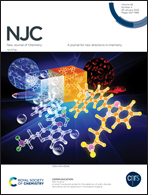Electronic state of a fluoranthene–urea compound and the kinetics of its emissive tautomer state in the presence of acetate anions†
Abstract
In order to investigate the electronic states of emissive tautomers (T*) of aromatic-urea compounds formed via excited-state intermolecular proton transfer (ESPT) with acetate anion (Ac), a new aromatic-urea compound (3FU) bearing fluoranthene, which has electron-accepting ability, was prepared. The absorption and fluorescence properties of 3FU were investigated using tetrabutylammonium acetate (TBAAc) and 1,8-diazabicyclo[5.4.0]undec-7-ene (DBU) as proton acceptors. In the presence of DBU, an N–H proton of 3FU is abstracted in the ground state to form an anionic structure, which is not given in the presence of TBAAc. The fluorescence spectrum of the proton-abstracted anionic structure was found to be almost identical to that of T* generated by ESPT with Ac, indicating that the electronic state of T* has an anionic structure. Furthermore, using the fluorescence quantum yield of the anionic structure, the deactivation rate constant of the normal form (N*) was estimated for the first time. Kinetic analysis using the obtained rate constant for N* allowed us to calculate the radiative and nonradiative rate constants of N* and T* and revealed that proton acceptors affect the nonradiative deactivation rate constant of N* rather than that of T*.



 Please wait while we load your content...
Please wait while we load your content...